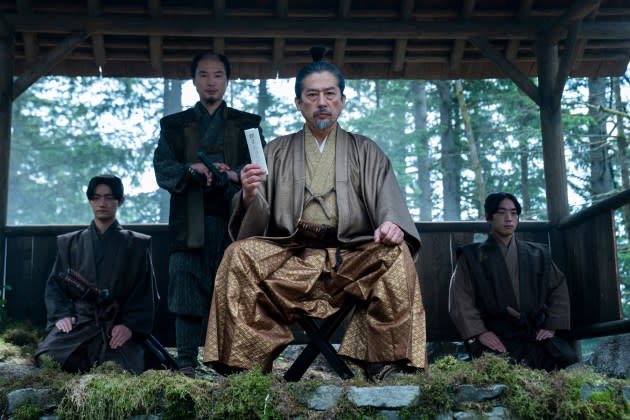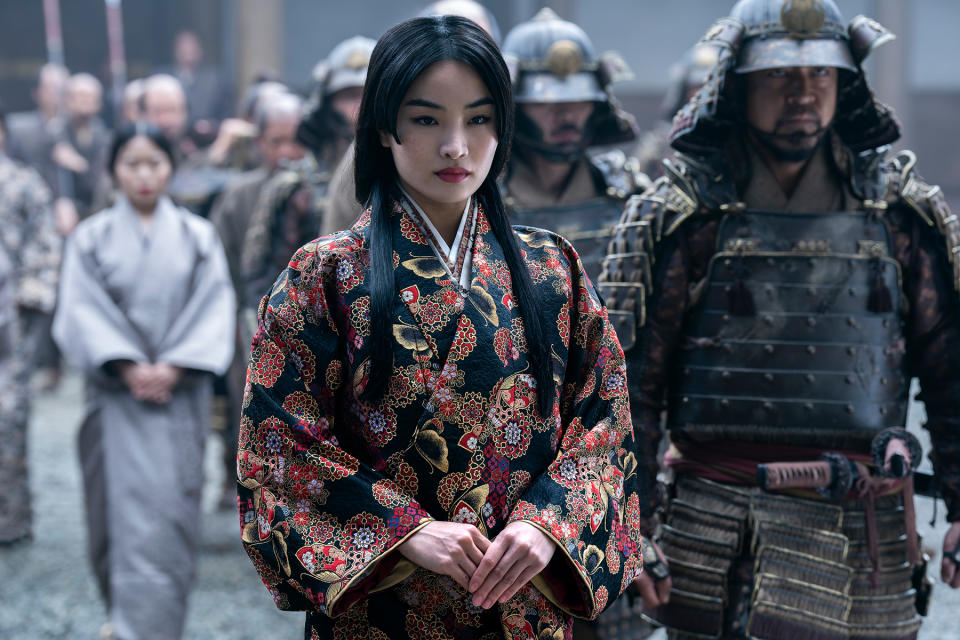‘Shōgun’ Exits Not With a Bang But a Whisper — and a Place in TV History
- Oops!Something went wrong.Please try again later.

This post contains spoilers for the finale of Shōgun.
Many years ago, when I first finished reading James Clavell’s historical epic Shōgun, I felt slightly puzzled. The novel had taken well over 1000 pages building to a civil war in feudal Japan between the wise Lord Toranaga and his ambitious rival Lord Ishido, and then it stopped right as the war was beginning, offering only the briefest of epilogues detailing what happened next? How was this good storytelling?, I wondered. Maybe there’s a sequel I don’t know about?
More from Rolling Stone
How to Watch 'American Horror Story: Delicate Part 2' Online (and Binge Every Other Season)
How to Watch 'Shōgun': Here's Where to Stream New Episodes Online for Free
'It Felt Like Fate to Play This Role': Hiroyuki Sanada's Journey from Japan to 'Shōgun'
Soon, though, I began to recognize that depicting the battles was utterly besides the point. Shōgun is a war story, but one where the war gets won or lost before swords are even drawn. It is about Toranaga the chess master seeing 12 moves ahead, and ensuring the board will be in his favor by the time his opponent begins to press the attack. We see everything Toranaga does in regards to Ishido; to interloping English sailor John Blackthorne; to loyal but frustrated counsel Mariko; to the duplicitous Yabushige; and more. Even if you don’t know the real Japanese history that inspired the book, the outcome is inevitable. The epilogue only confirms what we already know will happen.
FX’s big-budget Shōgun adaptation, whose finale began streaming on Hulu yesterday, did not bother with the epilogue. It instead concludes with Blackthorne (played by Cosmo Jarvis) salvaging the wreckage of his ship, the Erasmus, with help from Toranaga’s men. He glances up at Toranaga (Hioryuki Sanada), and the two uneasy allies share a silent moment of understanding, slightly nod at one another, and then Blackthorne returns to his ship while Toranaga looks up at the sky, serene and confident in what lies ahead for him.
In this case, though, there may be a sequel. There’s been abundant speculation in Hollywood about whether FX might submit Shōgun to the Emmys in the drama series categories, rather than as a limited series. Some of this would be gamesmanship — the miniseries field is wildly overstuffed this year, whereas the end of Succession has left the drama world as wide-open as it’s been in a long time. But it would require FX to make some kind of good faith effort towards this being a show that will have more than one season. So even though we can all tell what’s coming, based on the masterclass we’ve witnessed so far — by both Toranaga, and by series creators Rachel Kondo and Justin Marks — we could eventually see the war itself play out on our screens.
And even though Clavell didn’t need to depict that, this adaptation has earned the right to do it if Kondo, Marks, and company want to.
Many critics (myself included) compared Shōgun to Game of Thrones because of the sense of scale. The earthquake sequence from the middle of the season is as jaw-dropping a piece of spectacle as TV has seen outside of Westeros. But, like GoT at its best, Shōgun was incredible not because of the massive images it put on screen, but because of the fine level of detail with which it drew each of the players in its game, and how it allowed us to recognize and appreciate every move and countermove. It’s arguably even more thrilling just to see Toranaga unleash his latest plan, to watch Yabushige (Tadanobu Asano) attempt to align himself with both sides at once, or to see Mariko (Anna Sawai) prove herself endlessly loyal to her lord, even as he refused to grant her the death she has desired since her family’s disgrace years before.
As is often the case with these kinds of high-minded dramas, the penultimate episode, “Crimson Sky,” wound up being the emotional climax of the story, with Mariko sacrificing herself to help turn Ishido’s allies against him. The finale, “Dream of a Dream,” was largely about how everyone responded to her death, and about placing characters in position for the pending battle, whether or not it gets dramatized in a second season.
Which isn’t to say that “Dream of a Dream” lacked for great moments. Blackthorne was the weakest of the show’s main characters, which speaks less to Cosmo Jarvis’ solid work than to the way the show understandably gravitated more towards Mariko and the other natives, and to the ways their desires often came into conflict with Japanese traditions of honor during this period. But Blackthorne gets a standout scene in the finale where he offers to commit the ritualized suicide of seppuku if it means that Toranaga will spare the people of the fishing village who had been under the rule of the traitorous Yabushige. His grasp of the language is still primitive at best, but he has truly come to learn the culture and traditions from Mariko, from his widowed consort Fuji (Moeka Hoshi), and from watching Toranaga himself. Blackthorne is, of course, yet another piece on the board for Toranaga — either the rook, who moves straight ahead with brute force, or the knight, who moves in unpredictable ways compared to his allies — and this, like Toranaga secretly arranging for the burning of the Erasmus, is yet another test of loyalty. But it shows how far Blackthorne has come from the man who came to the east believing the Japanese to be less than human.
And there is the utterly sad and lovely scene towards the end where Yabushige prepares for seppuku before Toranaga, but first requests the indulgence of hearing more about exactly how his lord managed to outmaneuver Ishido and his allies. Tadanobu Asano’s performance — very much modeled on the work of Japanese legend Toshiro Mifune in his younger years (and who played Toranaga in the 1980 TV adaptation) — is the most purely entertaining of the series. But throughout, he is able to temper the character’s swagger with acknowledgment that this is a human being who is scared of the tenuous position in which he finds himself, and who has chosen to take this two-faced role because he can’t think of anything better. He is sad to die, but also pleased that he gets to more fully appreciate Toranaga’s genius before he goes. “How,” he wonders, “does it feel to shape the wind to your will?” Toranaga attempts to shrug off the compliment, insisting that he only studies the wind, rather than controlling it. But the self-effacing remark is almost immediately undercut when he acknowledges how expertly he deployed Mariko as the weapon that would eventually lead to his opponent’s ruin. “I could never send an army to Osaka,” he explains, “so I sent a woman to do what an army never could.”

And what a woman! Though Blackthorne and Toranaga are the series’ protagonists, Mariko was its beating heart, and Anna Sawai delivered its most complicated, riveting, and heartbreaking performance. As the member of Toranaga’s inner circle with the best command of Portugese (which we hear as English), Mariko has to serve as Blackthorne’s guide to this world, as well as ours. But she is also struggling with her family dishonor, her loathing of her abusive husband Buntaro (Shinnosuke Abe), her unexpected attraction to this uncouth Westerner, the sadness of being opposed by former childhood friend Ochiba (Fumi Nikaido), and more. She speaks a lot, but almost always while keeping her true emotions hidden behind the “eightfold fence” she teaches Blackthorne about. So Sawai has to reveal so much of what’s raging beneath that polite surface with her eyes, and with barely perceptible shifts in body language.
Midway through “Crimson Sky,” Mariko faces off with a few dozen members of Ishido’s personal guard. They make quick work of her own guards, and soon it is just this small, seemingly demure woman standing up to these large men of violence, determined to put on a show for all of Ishido’s other “guests” so that they will fully appreciate their true status as hostages. In that moment, Sawai’s performance looms so large that it would not be shocking if she were to somehow overtake her foes and walk out of the palace under her own steam. Instead, she is given the best possible reward: a death that releases her from a life she has long found painful, and that supports the cause of her lord, but also one caused by others, so she will not be damned to Hell according to the tenets of her Catholic religion. Even more than Toranaga, Mariko gets everything she wants.
A hypothetical second season would have to be made without both Sawai and Asano (barring some kind of unnecessarily fractured timeline that wouldn’t tell us anything we don’t already know). That might be reason enough to leave things well enough alone and go out roughly where Clavell did. But Sanada himself is great and charismatic, and the Jarvis’s scenes in these final episodes suggested that a Blackthorne who has mostly submitted himself to local tradition is a compelling character in his own right. If “Dream of a Dream” is all she wrote for Shōgun, then the story has been told in satisfying, often extraordinary fashion. And we can study the wind to see if conditions are favorable for that story to continue.
Best of Rolling Stone

